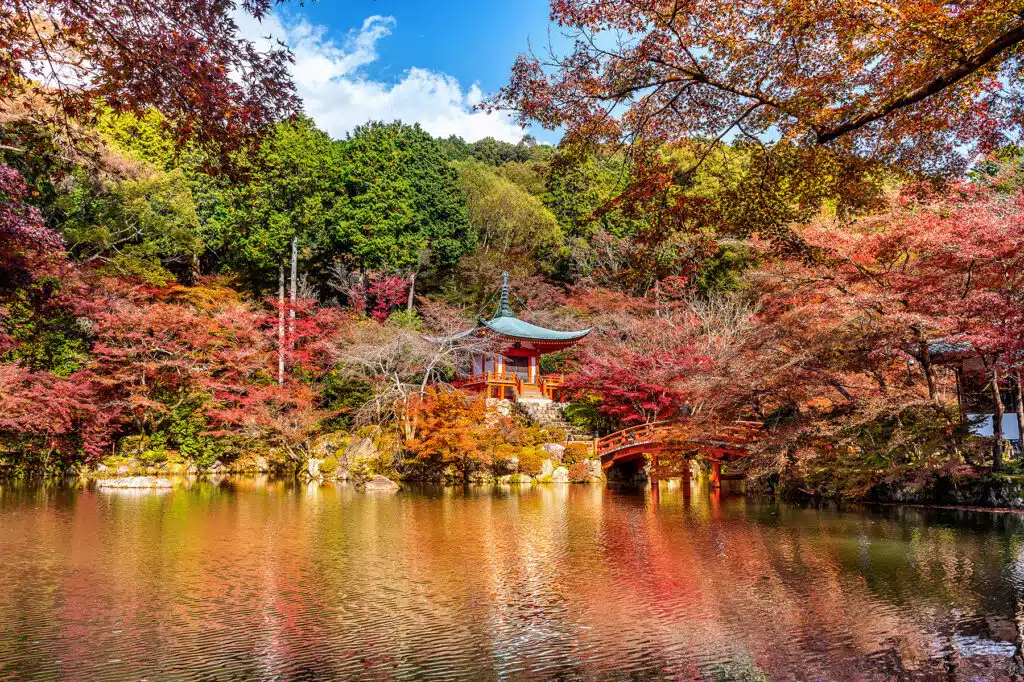Momijigari, find out about leaf-hunting in Japan

Autumn is one of the most fascinating seasons of the year, especially in Japan, where nature is a colourful show. Within this celebration of natural beauty, a tradition called Momijigari (紅葉狩り), which literally means “Autumn leaf hunting”, stands out. In this blog, we introduce you to this beautiful tradition and reveal the best places to experience it in Japan.
What is the Momijigari?
- Momiji (紅葉) means autumn leaves, representing leaves that change colour.
- Gari o Kari (狩り) means hunting; it is the action of hunting (or admiring) leaves. Originally, kari referred to hunting wild animals, such as bears and other wild animals. Eventually, the word came to be used to describe the observation of plants, leading to the term Momijigari.
Momijigari is a traditional Japanese practice of enjoying the beauty of the leaves during Autumn. As the weather gets cooler, the leaves of these trees turn to shades of red, orange and yellow, creating beautiful landscapes that the Japanese admire in parks, gardens and mountains.
This event has a similar cultural significance to Hanami, the sighting of the cherry blossoms in spring. We tell you more about Hanami in the blog: Hanami, the contemplation of the blossom.
Curiosity. Legend has it that the nobles did not go hunting animals, but actually went into the forests and plains to ‘hunt’ plants and trees, enjoying the beauty of nature.
Leaf hunting is a very important tradition in Japan, and is considered a time for reflection and meditation on the transitory nature of life. It is also a moment to enjoy the beauty of nature and the Autumn season.
Cultural meaning
Momijigari is not only a recreational activity, but also a way of connecting with nature and appreciating life, a concept deeply rooted in Japanese culture called Mono no aware (物の哀れ).
Best places to enjoy Momijigari in Japan
If you have the opportunity to travel to Japan in Autumn, here are some of the best places to enjoy Momijigari:
- Nikko National Park (Tochigi): known for its temples and sanctuaries, Nikko offers a spectacular background of mountains and waterfalls covered in red and gold leaves.
- Arashiyama (Kioto): known for its famous bamboo forest, Arashiyama is transformed in autumn with leaves covering the mountainsides and the Hozu River, creating a dreamlike landscape.
- Temple Kiyomizudera (Kioto): this iconic temple offers panoramic views of the city and the surrounding red-leafed landscape, creating a perfect combination of culture and nature.
- Shinjuku Gyoen Park (Tokio): an oasis in the heart of Tokyo, this park offers a variety of trees dressed in Autumn colours, making Momijigari an accessible experience even in the city.
- Mount Takao (Tokio): just an hour from central Tokyo, Mount Takao offers a trekking route with breathtaking views of maple leaves and, on clear days, even Mount Fuji.
How to enjoy Momijigari
Momijigari is an experience that goes beyond simply observing leaves. It is about immersing yourself in nature, enjoying relaxing walks and sharing the moment with friends and family. Here are some tips to make the most of this tradition:
- Planning your visit: the leaves change colour at different times depending on the location. Find out when is the best time to visit the places you want to visit.
- Take your camera: Momijigari offers unique photographic opportunities, so don’t forget your camera to capture the beauty of the moment.
- Relax and enjoy the moment: besides photography, take time to just be present and enjoy your surroundings without any rush.
- Take part in local events: many parks and temples organise special events during the Momijigari season, such as the nightly illumination of the leaves, which adds a magical feel to the experience.
Momijigari remind us of the importance of appreciating each moment and finding beauty in the impermanent. If you ever have the opportunity to experience Momijigari in person, do not hesitate to do so. It will be an unforgettable experience that will connect your spirit with nature and the rich Japanese culture.
Enjoy it at home!
Can’t you travel to Japan and experience Momijigari there? Enjoy this show in the natural landscapes around you.
Another option is to experience this show in your home with your bonsai. Deciduous bonsais allow you to experience the passing of the seasons in first person: the budding, change of colour and falling of the leaves, the appearance and subsequent ripening of the fruit in fruit bonsais… In the following blog, we tell you more about the care of deciduous bonsai and their cycle: All you need to know about deciduous bonsai.
You can also be interested in:
About the Author
Mistral Bonsai
In Mistral Bonsai we are a communication team, technicians and masters committed from the first day to disseminating the wonderful art of bonsai. A world that offers many things to share. We believe that a bonsai is a tree with a soul, unique and unrepeatable. Another of our most essential pillars is, how could it be otherwise, our close commitment to the preservation of the environment and nature.
Categories
Bonsai cultivation and care (60)
Bonsai gift (2)
Bonsai pests and diseases (7)
Bonsai repotting (3)
Bonsai species (1)
bonsai substrates (2)
Bonsai summer (1)
bonsai tools (1)
Bonsai work (13)
Ceramic pots (3)
Chinese culture (1)
Chinese culture (2)
Coniferous bonsai (2)
Conifers (1)


